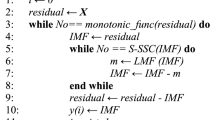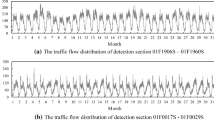Abstract
Long short-term memory (LSTM) is becoming increasingly popular in the short-term flow. In order to develop high-quality prediction models, it is worth investigating the LSTM potential deeply for traffic flow prediction. This study has two objectives: first, to observe the effect of using different sized training sets in LSTM training for various and numerous databases; second, to develop a clustering model that contributes to adjusting the training set size. For this purpose, 83 datasets were divided into certain sizes and LSTM model performances were examined depending on these training set sizes. As a result, enlargement of the training set size reduced LSTM errors monotonic for certain datasets. This phenomenon was modeled with the state-of-the-art clustering algorithms, such as K-nearest neighbor, support vector machine (SVM), logistic regression and pattern recognition networks (PRNet). In these models, statistical properties of datasets were utilized as input. The best results were obtained by PRNet, and SVM model performance was closest to PRNet. This study indicates that enlarging the training set size in traffic flow prediction increases the LSTM performance monotonically for specific datasets. In addition, a high-precision clustering model is presented to assist researchers in short-term traffic forecasting to adjust the size of the training set.







Similar content being viewed by others
References
Zhao Z, Chen W, Wu X et al (2017) LSTM network: a deep learning approach for short-term traffic forecast. IET Intel Transport Syst 11:68–75. https://doi.org/10.1049/iet-its.2016.0208
Ahmed MS, Cook AR (1979) Analysis of freeway traffic time-series data by using box-jenkins techniques. Transp Res Rec. https://doi.org/10.3141/2024-03
van Lint JWC, van Hinsbergen C (2012) Short term traffic and travel time prediction models, in artificial intelligence applications to critical transportation issues Transportation Research Circular National. Academies Press, Washington DC, Number E-C168
Kamarianakis Y, Prastacos P (2003) forecasting traffic flow conditions in an urban network: comparison of multivariate and univariate approaches. Transp Res Rec 1857:74–84. https://doi.org/10.3141/1857-09
Park D, Rilett LR (1998) Forecasting multiple-period freeway link travel times using modular neural networks. Transp Res Rec: J Transp Res Board 1617:163–170
Wu CH, Ho JM, Lee DT (2004) Travel-time prediction with support vector regression. IEEE Trans Intell Transp Sys 5(4):276–281
Nikovski D, Nishiuma N, Goto Y, Kumazawa H (2005) Univariate short-term prediction of road travel times. In: IEEE Conference on Intelligent Transportation Systems, Proceedings, ITSC. pp 1074–1079
Nagel K, Schreckenberg M (1992) A cellular automaton model for freeway traffic. J de Phys I 2:2221. https://doi.org/10.1051/jp1:1992277
Cremer M (1995) On the calculation of individual travel times by macroscopic models. In: Pacific Rim TransTech Conference. 1995 Vehicle Navigation and Information Systems Conference Proceedings. 6th International VNIS. A Ride into the Future. IEEE, pp 187–193
Williams BM (2001) Multivariate vehicular traffic flow prediction: Evaluation of ARIMAX modeling. Transp Res Rec. https://doi.org/10.3141/1776-25
Wu C-H, Ho J-M, Lee DT (2004) Travel-Time Prediction With Support Vector Regression. IEEE Trans Intell Transp Syst 5:276–281. https://doi.org/10.1109/TITS.2004.837813
Lingras P, Sharma S, Zhong M (2002) Prediction of recreational travel using genetically designed regression and time-delay neural network models. Transp Res Rec 1805(1):16–24
Smith BL, Williams BM, Keith Oswald R (2002) Comparison of parametric and nonparametric models for traffic flow forecasting. Transp Res Part C: Emerg Technol 10:303–321. https://doi.org/10.1016/S0968-090X(02)00009-8
Kamarianakis Y, Prastacos P (2003) Forecasting Traffic Flow Conditions in an Urban Network: Comparison of Multivariate and Univariate Approaches. Transp Res Rec: J Transp Res Board 1857:74–84. https://doi.org/10.3141/1857-09
Sun B, Cheng W, Goswami P, Bai G (2018) Short-term traffic forecasting using self-adjusting k-nearest neighbours. IET Intel Transport Syst 12:41–48. https://doi.org/10.1049/iet-its.2016.0263
Doğan E (2020) Short-term Traffic Flow Prediction Using Artificial Intelligence with Periodic Clustering and Elected Set. Promet-Traffic Transp 32:65–78
Xie Y, Zhang Y, Ye Z (2007) Short-term traffic volume forecasting using Kalman filter with discrete wavelet decomposition. Computer-Aided Civil and Infrastructure Engineering 22:326–334. https://doi.org/10.1111/j.1467-8667.2007.00489.x
Tsekeris T, Stathopoulos A (2010) Short-Term Prediction of Urban Traffic Variability: Stochastic Volatility Modeling Approach. Journal of Transportation Engineering 136:606–613. https://doi.org/10.1061/(ASCE)TE.1943-5436.0000112
McCrea J, Moutari S (2010) A hybrid macroscopic-based model for traffic flow in road networks. Eur J Operational Res 207:676–684. https://doi.org/10.1016/j.ejor.2010.05.018
Vlahogianni EI, Karlaftis MG, Golias JC (2014) Short-term traffic forecasting: Where we are and where we’re going. Transportation Research Part C: Emerging Technologies 43:3–19. https://doi.org/10.1016/j.trc.2014.01.005
Hochreiter S, Schmidhuber J (1997) Long Short-Term Memory. Neural Comput 9:1735–1780. https://doi.org/10.1162/neco.1997.9.8.1735
Yang B, Sun S, Li J et al (2019) Traffic flow prediction using LSTM with feature enhancement. Neurocomputing 332:320–327. https://doi.org/10.1016/j.neucom.2018.12.016
Liu J (2017) LSTM network: a deep learning approach for short-term traffic forecast. IET Intel Transport Sys 11:68–75
Lv Y, Duan Y, Kang W et al (2015) Traffic Flow Prediction with Big Data: A Deep Learning Approach. IEEE Trans Intell Transp Syst 16:865–873. https://doi.org/10.1109/TITS.2014.2345663
Wu Y, Tan H, Qin L et al (2018) A hybrid deep learning based traffic flow prediction method and its understanding. Transp Res Part C: Emerg Technol 90:166–180. https://doi.org/10.1016/j.trc.2018.03.001
Tian Y, Zhang K, Li J et al (2018) LSTM-based traffic flow prediction with missing data. Neurocomputing 318:297–305. https://doi.org/10.1016/j.neucom.2018.08.067
Zhao Z, Chen W, Wu X et al (2017) LSTM network: a deep learning approach for short-term traffic forecast. IET Intel Transport Syst. https://doi.org/10.1049/iet-its.2016.0208
Luo X, Li D, Yang Y (2019) Zhang S (2019) Spatiotemporal traffic flow prediction with KNN and LSTM. Journal of Advanced Transportation 5:1–10. https://doi.org/10.1155/2019/4145353
Yu R, Li Y, Shahabi C, et al (2017) Deep learning: A generic approach for extreme condition traffic forecasting. In: Proceedings of the 2017 SIAM International Conference on Data Mining. SIAM, pp 777–785
Hochreiter S (1998) The vanishing gradient problem during learning recurrent neural nets and problem solutions. Int J Uncertain, Fuzziness Knowl-Based Sys 6:107–116
Polson NG, Sokolov VO (2017) Deep learning for short-term traffic flow prediction. Transp Res Part C: Emerg Technol 79:1–17. https://doi.org/10.1016/j.trc.2017.02.024
Çodur MY, Tortum A (2015) An Artificial Neural Network Model for Highway Accident Prediction: A Case Study of Erzurum, Turkey. PROMET-Traffic Transp 27:217–225. https://doi.org/10.7307/ptt.v27i3.1551
Celikoglu HB (2013) An Approach to Dynamic Classification of Traffic Flow Patterns. Comp-Aided Civil Infrastruct Eng 28:273–288. https://doi.org/10.1111/j.1467-8667.2012.00792.x
Akgüngör AP, Doğan E (2009) An artificial intelligent approach to traffic accident estimation: Model development and application. Transport 24:135–142. https://doi.org/10.3846/1648-4142.2009.24.135-142
PeMS PeMS Data Clearinghouse. http://pems.dot.ca.gov/?dnode=Clearinghouse. Accessed 12 Aug 2019
Mann HB (1945) Nonparametric tests against trend. Econometrica 13(3):245–259. https://doi.org/10.2307/1907187
Kendall MG (1948) Rank correlation methods. Griffin
Yu Y-S, Zou S, Whittemore D (1993) Non-parametric trend analysis of water quality data of rivers in Kansas. J Hydrol 150:61–80
Bishop CM (2006) Pattern recognition and machine learning. Springer-Verlag, New York
Mitchell TM (1997) Artificial neural networks. Machine Learn 45:81–127
Kingma DP, Ba JL (2015) Adam: A method for stochastic optimization. 3rd International Conference on Learning Representations, ICLR 2015 - Conference Track Proceedings 1–15
Reimers N, Gurevych I (2017) Optimal hyperparameters for deep LSTM-networks for sequence labeling tasks. ArXiv, abs/1707.06799
Møller MF (1993) A scaled conjugate gradient algorithm for fast supervised learning. Neural Networks 6:525–533
Jolliffe IT, Cadima J (2016) Principal component analysis: a review and recent developments. Philosl Trans R Soc A: Math, Phys Eng Sci 374:20150202
Funding
Not applicable.
Author information
Authors and Affiliations
Corresponding author
Ethics declarations
Conflict of interest
The author declares that they have no conflict of interest.
Avaliability of data and material
The datasets generated during and/or analyzed during the current study are available in the [Caltrans Performance Measurement System] repository, [http://pems.dot.ca.gov/?dnode=Clearinghouse&type=station_hour&district_id=4&submit=Submit/
Additional information
Publisher's Note
Springer Nature remains neutral with regard to jurisdictional claims in published maps and institutional affiliations.
Appendix
Rights and permissions
About this article
Cite this article
Doğan, E. LSTM training set analysis and clustering model development for short-term traffic flow prediction. Neural Comput & Applic 33, 11175–11188 (2021). https://doi.org/10.1007/s00521-020-05564-5
Received:
Accepted:
Published:
Issue Date:
DOI: https://doi.org/10.1007/s00521-020-05564-5




